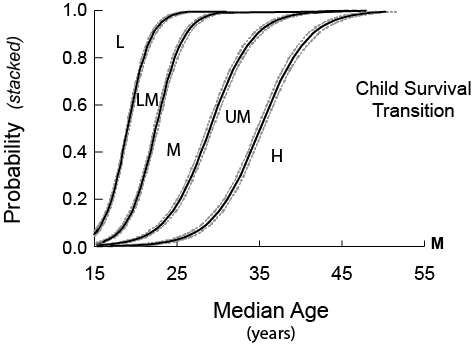Child Survival Transition (comprised of 4 models).
The age-structural model of child survival differentiates this variable using 5 categories (Fig. 1) that disaggregate countries based on their level of under-5 mortality: low (≥100.0 deaths per 1000 live births), lower-middle (50.0 to 99.9), middle (25.0 to 49.9), upper-middle (10.0 to 24.9), and high (<10.0).
- states with populations under 5.0 million are likely to attain the middle and upper-middle categories at younger median ages than more populous states,
- states relying on natural resource wealth (>15% of GDP) are likely to attain all categories, except the high child survival category, at younger median ages than non-resource reliant states;
- states in the low, lower-middle, middle and high income categories that are involved in a high-intensity conflict (>1000 battle-related deaths per year) are likely to enter categories later than others. Note that most conflicts (both high and low intensity) occur within states in the low, lower-middle and middle child survival categories;
- the point at which 50 percent of all countries are expected to be within the lower-middle child survival category, or a higher category (upper-middle or high) is at a median age of 18.8 (±0.2) For the middle child survival category, that point is at 22.1 (±0.8) years; for the upper-middle category, at 28.8 (±0.4) years; and for the high category.

